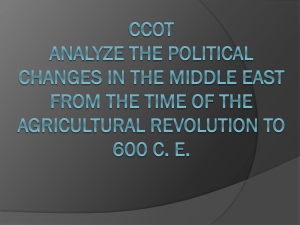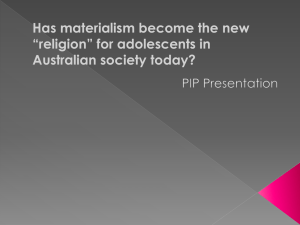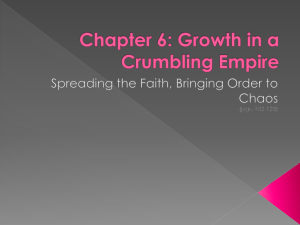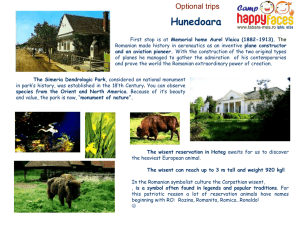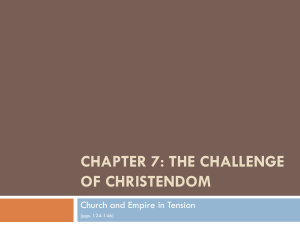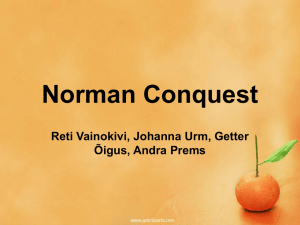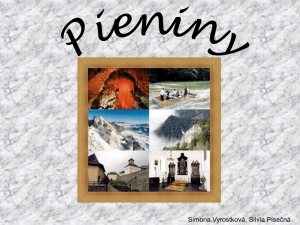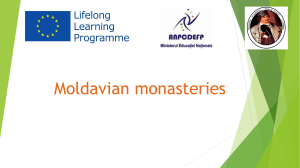Chapter five The Early Medieval World
advertisement
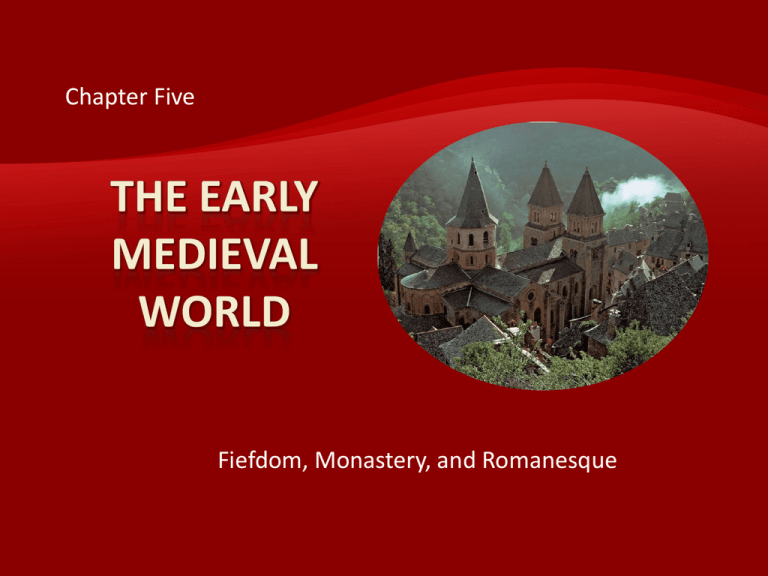
Chapter Five Fiefdom, Monastery, and Romanesque • After the Romans left England in 406, Germanic and Norse tribes— Angles, Saxons, Jutes, and Frisians—invited as mercenaries by Romanized British leaders, began to operate on their own • Their Anglo-Saxon culture, steeped in Germanic and Norse values and traditions, came to dominate cultural life in Britain • Christianity almost completely disappeared • Feudalism, in which a stronger patron provided protection to a weaker client in exchange for his loyalty, became the dominant system • First excavated in 1939, Sutton Hoo, near the modern city of Ipswich, England, yielded a burial mound containing the remains of a wealthy and powerful Anglo-Saxon man, probably a seventh-century king • A 90' long and 14' wide treasure-filled ship had been used as the final resting place of the man • An elaborate burial ceremony, which included cremation—forbidden by Christianity—and apparent human and animal sacrifice • Only two objects discovered at the site show any evidence of a Christian culture—two silver spoons inscribed with the names Saulos and Paulos in Greek lettering Note the symmetrical design, the combination of interlaced organic and geometric shapes, and the animal motifs of this cloisonné purse lid. In the burial site, it contained gold coins and ingots. • After the Romans withdrew from Britain in 406, Christianity had survived only in the westernmost reaches of the British Isles—Cornwall, Wales, and Ireland • Around 563, monasteries began to be established, marking beginning of the “re-Christianization” of Britain • The Celtic Christian church differed from Roman Christianity by celebrating Easter on the vernal equinox, believing Mary was exempt from original sin, and placing authority with the abbots and abbesses instead of the bishop. It invented private confession • The task of Christian missionaries in England was to transfer the allegiance of the people from their king, or thane, to God • They could not offer gold, or material wealth, but only salvation, or spiritual fulfillment • They illuminated their manuscripts with a rich decorative vocabulary, adorning Christianity in gold and silver, jewels and enamel, and placing it within the architecture of the most magnificent kind • The carpet page of the Lindisfarne Gospels is an example of a Celtic cross, supposedly created by St. Patrick when he made the mark of a Latin cross through an ancient pagan stone monument • The corner designs of the page recall the decorations on the Sutton Hoo purse cover • Made in the monastery on the Scottish island of Iona in the late 8th century • The Greek letters chi, rho, and iota, an abbreviation of Christi , form the basis of this page’s design, which illustrates one of the most beautiful capitals • So great was the renown of this book that in 1066 it was referred to as “the chief relic of the Western world” • The Franks were one of the many Germanic tribes that had moved westward beginning in the 4th century CE • By 732 Christianity was firmly established in France • Under the leadership of Charlemagne, the Frankish kingdom grew to include all of modern-day France, Holland, Belgium, Switzerland, and almost all of Germany, Northern Italy and Corsica, and Navarre in Northern Spain • Charlemagne brought one after another pagan tribe to submission, forcing them to give up their brand of Christianity and submit to Rome’s Nicene Creed • On Christmas Day 800 in Rome, Pope Leo III crowned Charlemagne emperor, creating what later would be known as the Holy Roman Empire • The monastery was a central part of Carolingian tradition, arguably its most important institution • Monastic life, as developed by Benedictine of Nursia (ca. 457-547), was to be a community of like-minded people in the pursuit of religious perfection who possessed nothing of their own and were never to marry • The Swiss monastery of St. Gall, near Lake Constance, was Charlemagne’s ideal monastery. Laid out in modules, or standard units of 2½', its functional, orderly plan was used in many Benedictine monasteries • The nave and the transept of the church, each 40' wide, are composed of 16 modules. Each monk’s bed was to be 2½ modules. The width of each garden path was 1¼ modules • This systematic arrangement reflects an increasing tendency in medieval thinking to regard Christianity as a logical and rational philosophy of life • Religious life offered women, generally the daughters of aristocrats, an alternative to life as a housewife or worker • One of the foremost women of the age was Hildegard of Bingen (10981179), who ran the monastery at Bingen, near Frankfurt, Germany • Although she wrote tracts on natural science, medicine, and the treatment of disease, an allegorical dialogue between the vices and virtues, and a significant body of devotional songs, she is best known as the first in a long line of female Christian visionaries and mystics • The Capetian dynasty was begun by Hugh Capet in 987. Their most contentious relationship was with the dukes of Normandy, an area that had been claimed by Viking raiders • In 1066, William of Normandy (later William I, the Conqueror) claimed the English throne on the death of the heirless English king Edward the Confessor on January 5, 1066 • Bayeux Tapestry, commissioned by William’s half-brother, the Bishop Odo of Bayeux, narrates the Battle of Hastings and William’s ascension to the throne. Thus England and northern France became one country with one king Below, Harold swears allegiance to William, his right hand on the altar between them, and his left on a chest presumably housing sacred objects from the Cathedral at Bayeux This, the first section of the tapestry, depicts Edward the Confessor talking to Harold, earl of Wessex, his wife’s brother. He is sending Harold on a mission to France, ostensibly to tell William, duke of Normandy, that he will be Edward’s successor Having returned to England just before Edward’s death and having assumed the throne, Harold is disturbed by the arrival of Halley’s Comet, visible in the top border. The comet would have been seen by the Anglo-Saxons as a portent of disaster and resulting, the tapestry implies, from his having broken his oath Harold, with the green shield, receives an arrow to the eye at the Battle of Hastings. Immediately to the right, a Norman soldier slays him Throughout the Middle Ages it was customary for Christians to do penance by going on a religious pilgrimage The most popular (and also most difficult and hence potentially most rewarding) sites for these pilgrimages were Jerusalem, Rome, and Santiago de Compostela, in the northwest corner of modern Spain, where the body of Saint James the Greater lay at rest Specific routes soon developed that allowed pilgrims to visit other sacred sites that housed relics—bones, clothing or other possessions of Christian saints and martyrs—along the way • Pilgrimage sites were quick to capitalize on the sometimes massive visitations • From 1050 to 1200 so-called pilgrimage churches arose in France and Spain • Their architecture and decoration define a period called the Romanesque, “in the manner of the Romans,” because they incorporated elements of Roman architectural style—the basilica tradition, portals modeled after Rome’s triumphal arches • The Abbey Church of Sainte-Foy is one of the oldest of the pilgrimage churches • With wide aisles and a two-story gallery, it was built to accommodate large numbers of visitors • The space created by the barrel vault, a distinctive feature of Romanesque architecture, was designed to raise the worshipping pilgrims’ eyes and thus direct their thoughts to heaven • Saint Foy (Saint Faith) was a child who was martyred in 303 for refusing to worship pagan gods • Her skull was contained in an elaborate jeweled reliquary that stood in the choir of the church Portals of Romanesque churches were of special importance as they were the first thing the visitor would see; they also marked the boundary between secular and sacred space All elements of the Romanesque portals were subject to decorative relief—the tympanum (the space under the arch), the lintel jambs (the vertical elements on both sides of the door), the trumeau (the column or post in the middle of the door), and the archivolt (the curved molding formed by the voussoirs making up the arch) Cluny, founded in about 910, was a reformed Benedictine monastery that controlled most of the pilgrimage churches In 1088, Abbot Hugh de Semur began work on a new church for the abbey The entire arrangement reflects the ideal Carolingian monastery at Saint-Gall. In the twelfth century, it was described as “something of the likeness of the paradise of God” "Third Abbot Cathedral” Video will play automatically. From Cluny: A Light in the Night (length: 4:33). Item #8636 © 1995 from FMG The Crusades were four attempts (1096-1204) to retake the holy lands from Muslim control On November 25, 1095, at the Council of Clermont, Pope Urban II (pope 1088-1099) preached the First Crusade The First Crusade was motivated by several factors: religious zeal, the desire to reduce conflict at home by sending off Europe’s feuding aristocrats, defending Christendom from barbarity, the promise of monetary reward, and the nobility’s hot blood and sense of adventure Of all the medieval castles of Europe and the Middle East, none survives that is as impressive as Krak des Chevaliers in northern Syria Krak des Chevaliers was modeled on the castle-fortresses built by the Normans in England and northern France First occupied by Crusaders in 1109, it was used beginning in 1142 as a hospital for the sick and wounded. Twelve times it withstood siege before finally falling to Berber invaders in 1271 One of the greatest beauties in Europe, Eleanor of Aquitaine was wife to two kings—Louis VII of France and King Henry II of England From 1170 to 1179 Eleanor and her daughter by Louis VII, Marie, lived in Poitiers and established the city as the center of a secular culture and literary movement that celebrated the art of courtly love Troubadour poets, most of them men but a few women (trobairitz), can be said to have “invented” romantic love as we know it today: longing for a woman of higher status, suffering, lying sleepless at night, losing one’s appetite, willing to perform any deed to win his lady’s favor At the left, a lady listens as a troubadour poet expresses his love for her In the center is a knight, sword in one hand and key to the lady’s heart in the other On the right the knight kneels before the lady; the rope around his neck, held by her, signifies his fidelity to her


